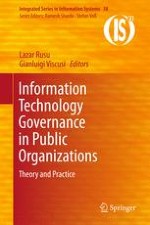2017 | OriginalPaper | Buchkapitel
7. Business and IT Architecture for the Public Sector: Problems, IT Systems Alternatives and Selection Guidelines
verfasst von : Martin Henkel, Erik Perjons, Eriks Sneiders
Erschienen in: Information Technology Governance in Public Organizations
Aktivieren Sie unsere intelligente Suche, um passende Fachinhalte oder Patente zu finden.
Wählen Sie Textabschnitte aus um mit Künstlicher Intelligenz passenden Patente zu finden. powered by
Markieren Sie Textabschnitte, um KI-gestützt weitere passende Inhalte zu finden. powered by
